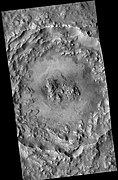奧基隕擊坑
外觀
奧基隕擊坑(Auki)是火星第勒尼安海區的一座撞擊坑,其中心坐標位於南緯15.76度、西經263.13度。它的直徑約為40公里, 2015年,國際天文聯合會(IAU)行星系統命名工作組(WGPSN)以所羅門群島馬萊塔省奧基市命名了它[1]。
奧基隕擊坑坐落着一座中央峰,撞擊坑通常有一圈被噴射物環繞的邊緣,相比之下,火山坑通常沒有邊緣或噴射沉積物。當隕石坑越大(直徑超過10公里)時,坑底中心通常就有一座中央峰[2],這種山峰是撞擊後坑底地表反彈所形成[3]。
一組研究奧基隕擊坑的研究人員報告了熱液作用的有力證據,該隕坑中分佈的山脊可能是在撞擊產生的裂縫之後形成的。他們利用火星勘測軌道飛行器上的儀器發現了蒙脫石、二氧化矽、沸石、蛇紋石、碳酸鹽以及在地球上撞擊誘發的熱液系統中常見的綠泥石等礦物[4][5][6][7][8][9] ,其他研究火星隕坑的科學家也提供了火星撞擊後熱液系統的另外證據[10][11][12]。
撞擊會擊碎岩石並產生大量可能持續數千年的熱量[13],這種熱量可以從熱液循環中產生出新的礦物。地球上的撞擊隕石坑曾產生了一些有用的礦物。地球上與撞擊效應相關的礦石包括鐵、鈾、金、銅和鎳等,據估計,僅在北美,從撞擊構造中開採的礦料價值就高達50億美元/年[14]。雖然在火星上尚未找到任何值得花費高昂成本向地球運送的東西,但未來的定居者從火星上獲取的必要礦石越多,也就越容易在這顆紅色星球上建立棲息地[15]。
-
顯示奧基隕擊坑與附近其他特徵位置的地形圖,顏色代表高程。
-
背景相機拍攝的奧基隕擊坑全景圖
-
高解像度成像科學設備對奧基隕擊坑中心部分的近距離觀察,箭頭指示了山脊線,沙丘出現在圖像頂部附近。
-
上一幅高解像度山脊圖像的近視圖,箭頭指示了一處「X」形山脊線。
-
奧基隕擊坑中央部分近視圖,顯示了箭頭指示的山脊,這是前一幅高解像度成像科學設備所拍攝圖像的放大版。
另請查閱
[編輯]參引資料
[編輯]- ^ "奧基隕擊坑". Gazetteer of Planetary Nomenclature. USGS Astrogeology Research Program.
- ^ 存档副本. [2021-08-18]. (原始內容存檔於2016-01-14).
- ^ Hugh H. Kieffer. Mars. University of Arizona Press. 1992 [7 March 2011]. ISBN 978-0-8165-1257-7. (原始內容存檔於2017-03-12).
- ^ Carrozzo, F. et al. 2017. Geology and mineralogy of the Auki Crater, Tyrrhena Terra, Mars: A possible post impact-induced hydrothermal system. 281: 228-239
- ^ Loizeau, D. et al. 2012. Characterization of hydrated silicate-bearing outcrops in tyrrhena Terra, Mars: implications to the alteration history of Mars. Icarus: 219, 476-497.
- ^ Naumov, M. 2005. Principal features of impact-generated hydrothermal circulation systems: mineralogical and geochemical evidence. Geofluids: 5, 165-184.
- ^ Ehlmann, B., et al. 2011. Evidence for low-grade metamorphism, hydrothermal alteration, and diagenesis on Mars from phyllosilicate mineral assemblages. Clays Clay Miner: 59, 359-377.
- ^ Osinski, G. et al. 2013. Impact-generated hydrothermal systems on Earth and Mars. Icarus: 224, 347-363.
- ^ Schwenzer, S., D. Kring. 2013. Alteration minerals in impact-generated hydrothermal systems – Exploring host rock variability. Icarus: 226, 487-496.
- ^ Marzo, G., et al. 2010 Evidence for hesperian impact-induced hydrothermalism on Mars. Icarus: 667-683.
- ^ Mangold, N., et al. 2012 Hydrothermal alteration in a late hesperian impact crater on Mars. 43rd Lunar and Planetary Science. #1209.
- ^ Tornabene, L., et al. 2009. Parautochthonous megabreccias and possible evidence of impact-induced hydrothermal alteration in holden crater, Mars. 40th LPSC. #1766.
- ^ Dohm, J.; Hare, T.; Robbins, S.; Williams, J.-P.; Soare, R.; El-Maarry, M.; Conway, S.; Buczkowski, D.; Kargel, J.; Banks, M.; Fairén, A.; Schulze-Makuch, D.; Komatsu, G.; Miyamoto, H.; Anderson, R.; Davila, A.; Mahaney, W.; Fink, W.; Cleaves, H.; Yan, J.; Hynek, B.; Maruyama, S. (2015). "Geological and hydrological histories of the Argyre province, Mars". Icarus. 253: 66–98. Bibcode:2015Icar..253...66D. doi:10.1016/j.icarus.2015.02.017.
- ^ Grieve, R., V. Masaitis. 1994. The Economic Potential of Terrestrial Impact Craters. International Geology Review: 36, 105-151.
- ^ Larry O'Hanlon. Mining Mars? Where's the Ore?. Discovery News. February 22, 2010 [2021-08-18]. (原始內容存檔於2012-10-22).
推薦閱讀
[編輯]- Lorenz, R. 2014. The Dune Whisperers. The Planetary Report: 34, 1, 8-14





